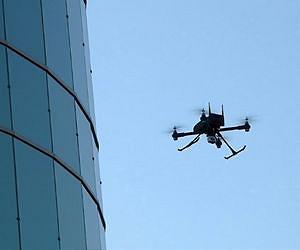University of Granada researchers have developed a 3D imaging system that scans 3D models of historical buildings using data obtained from an unmanned aerial vehicle (UAV)-an aircraft without a human pilot onboard. This is the first 3D imaging system to combine the use of UAVs, image-based 3D modeling technologies, and virtual representation of models to produce a realistic modeling of 3D objects from images.
The endpoint of this project is to obtain a 3D model of a historical building facade -as a cathedral-without any human intervention and at a lower cost than other technologies currently available (as 3D scanners). To date, UAVs have been used in many research fields, as they are fast and they can overfly abrupt areas, avoid large obstacles and provide information from multiple sensors.
No Scaffolding or Cranes
While UAVs autonomy is limited, they can descend for an operator to change the battery (an operation requiring just a few seconds), and then resume its task. This way, the object can be scanned in record time without the need for scaffolding or cranes.
As regards 3D-digitalization technologies, they can provide a realistic modeling of 3D objects from images obtained from sensors, stereoscopic cameras, multiple geolocated images obtained from different angles, etc. Finally, virtual reality technologies produce realistc high-quality 3D images (similar to those on 3D movies).
The multiple applications of this technology are evident, as they offer an autonomous device that in just some minutes can scan a facade with as much or a higher precision than 3D scanners. It is noteworthy that this device can get close to the object up to a few inches to obtain the smallest and unreachable details.
This project focused on facade 3D imaging is intended to prove the applicability of this new technology to any type of architectural model: buildings, monuments, etc. What these objects have in common is that digitalization is performed in vertical parameters and that objects are geolocalized.
Financing from CEI BioTic
Different University of Granada research groups have participated in this project: the Grupo de Modelos de Decision y Optimizacion (MODO), the Grupo de investigacion en Informatica Grafica (GIIG); the University of Granada Virtual Reality Laboratory and the companies Intelligenia Dynamics and Virtum Graphics, which are University of Granada spin-offs and are aggregated to the Biotic Campus of International Excellence (CE). In fact the CIE will support this research project.
Finally, this Project is also supported by the Patronato de la Alhambra y el Generalife an CETURSA Sierra Nevada S. A, which belongs to the Junta de Andalucia.
Source: University of Granada










